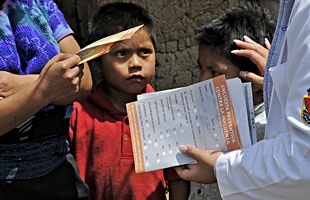Surveillance & monitoring
The WHO’s Global Influenza Programme (GIP) provides global standards for influenza surveillance. In addition GIP collects and analyses virological and epidemiological influenza surveillance data from around the world. The regular sharing of quality influenza surveillance and monitoring data by countries allows WHO to:

Case definitions for influenza surveillance
As of January 2014
The WHO global influenza surveillance standards define the surveillance case definitions for influenza-like illness (ILI) and severe acute respiratory infections (SARI).
Key messages when using the case definitions:
- Influenza infection causes a clinical syndrome not easily distinguished from other respiratory infections.
- The case definitions for ILI and SARI are not necessarily intended to capture all cases but to describe trends over time.
- Using one common case definition globally will allow national health authorities to interpret their data in an international context.
ILI case definition Acute respiratory infection with:
| SARI case definition Acute respiratory infection with:
|
Selected manuals and protocols
Publications
All →Regional guidelines for influenza surveillance
Health topics
